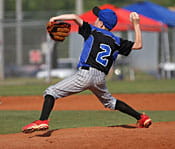What is Little League Elbow?

- Repeated overhead throwing without proper rest
- Pitching and throwing with improper mechanics
- Lack of muscle strength, specifically in the shoulder
- Pitching too much
If untreated, the condition can worsen, leading to bone and/or ligament damage. There is a small chance for premature growth plate closure or fracture involving the growth plate, which could require casting or surgery. The good news is that little league elbow will often heal completely with rest and a dedicated rehabilitation program.
How Do I Know If My Child Has Little League Elbow?
Symptoms of little league elbow include:
- Pain to inner elbow with pitching or throwing
- Swelling to the inner elbow
- Trouble extending the elbow completely
- Decreased throwing speed and/or accuracy
How Is it Diagnosed?
A doctor will complete a detailed physical exam and may order imaging tests. The diagnosis of little league elbow and how severe it is can be usually be made with X-ray imaging, which is done while your child is in the clinic. In certain cases, an MRI may be helpful.
Types of diagnostic tests:
- X-ray: the most common test for an elbow injury. This test will tell whether your child has had bone damage, including fracture, necrosis (dead bone) or growth plate irregularities.
- Magnetic resonance imaging (MRI): provides a more detailed image of both soft tissues and bone. It can look at tendons and ligaments, which cannot be seen with X-rays alone.
How Do I Treat Little League Elbow?
Once the diagnosis of little league elbow is made, your doctor will determine the best possible treatment plan.
Conservative management:
- Rest – your doctor may suggest you avoid throwing activities for a period of time.
- Ice – this helps to decrease swelling, bleeding, and pain in the elbow.
- Physical therapy – under the guidance of a certified physical therapist, your child will undergo a strengthening and stretching regimen that will focus on strengthening of the arm and shoulder muscles.
- Video throwing analysis – at Cincinnati Children’s, we are able to perform two-dimensional video analysis of throwing motion. Trained therapists are able to break down the phases of throwing to look for deficiencies.
- Return-to-throwing program – once cleared to return to throwing, the athlete will undergo a progressive throwing program that slowly increases the forces and demands through the arm and shoulder, which are necessary for full return to competitive play.
Prevention
While no injury can be completely prevented, proper mechanics, rest and strengthening can reduce the risks of injury. USA Baseball has developed guidelines for young players to help reduce the risk of injury.
Recommended pitch counts by age and associated rest periods:
|
Age of Athlete |
Pitch Limits per Day |
|
17-18 |
105 |
|
13-16 |
95 |
|
11-12 |
85 |
|
10-under |
75 |
|
Number of Pitches Thrown |
Days of Rest |
|
1-20 |
0 |
|
21-40 |
1 |
|
41-60 |
2 |
|
61+ |
3 |
(Courtesy of Little League Baseball)
Parents need to also be aware of any reports of pain, fatigue or changes in throwing motions as these are often warning signs that if ignored may lead to more serious injury.



